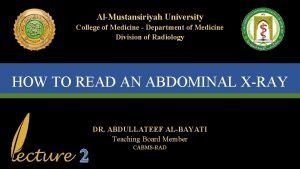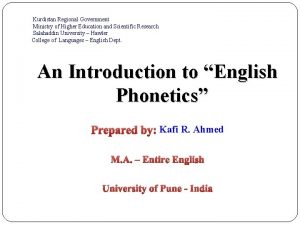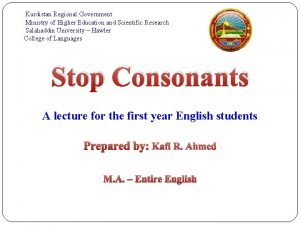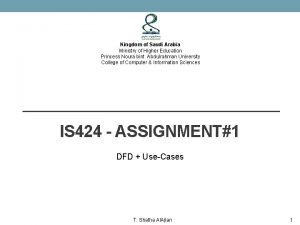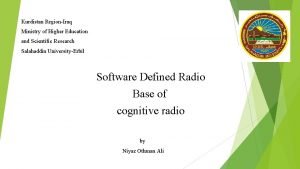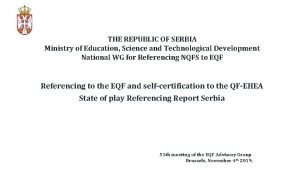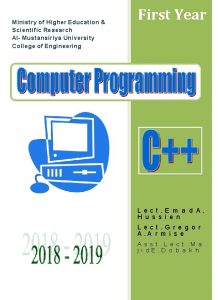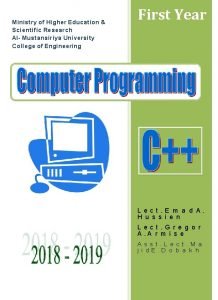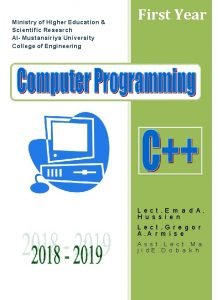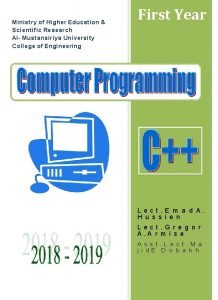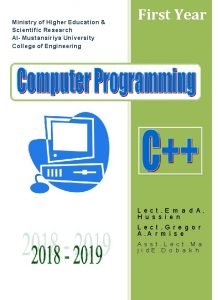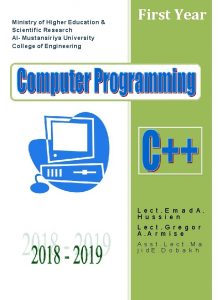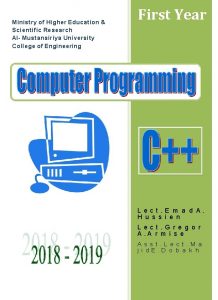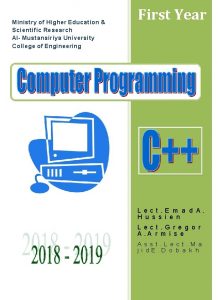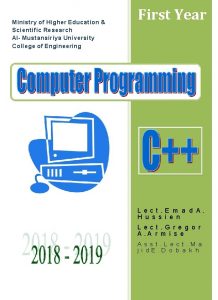Ministry of Higher Education Scientific Research Al Mustansiriya











- Slides: 11

Ministry of Higher Education & Scientific Research Al- Mustansiriya University College of Engineering First Year L e c t. E m a d A. H u s s i e n L e c t. G r e g o r A. A r m i s e A s s t. L e c t. M a j i d E. D o b a k h

Lecture 3 1 Character set: C++ has the letters and digits, as show below: Uppercase: A, B, C, . . . , Z Lowercase: a, b, c, . . . , z Digits: 0, 1, 2, . . . , 9 Special Characters: All characters other than listed treated as special characters for example: “ + - * / ^ ( [ { } ] ) < = > (Double Conations) . (Dot) : (Colon) ; (Semicolon) , (Comma) (Blank Space) In C++ language, upper case and lower case letters are distinct and hence there are 52 letters in all. For example bag is different from Bag which is different from BAG. 2 Identifiers: An identifier is a name given to some program entity, such as variable, constant, array, function, structure, or class. An identifier is a sequence of alphanumeric (alphabetic and numeric) characters, the first of which must be a letter, and can’t contain spaces. The length of an identifier is machine dependent. C++ allows identifiers of up to 127 characters. A variable should not begin with a digit. C++ does not set a maximum length for an identifier. Some examples of valid identifiers are as follows: My_name (7 char. ) i (1 char. ) B (1 char. )

Examples of invalid identifiers are: 3 ab a()test ros sal 3 Keywords: The keywords are also identifiers but cannot be user defined, since they are reserved words. All the keywords should be in lower case letters. Reserved words cannot be used as variable names or constant. The following words are reserved for use as keywords: Some of C++ Language Reserved Words: break delete float long sizeof case double for main switch char else goto private true cin enum if public union cout false int short void 4 Constants: There are three types of constants: string constants, numeric constants, and character constants. 1. String Constants: A string constants are a sequence of alphanumeric characters enclosed in double quotation marks whose maximum length is 255 characters. In the following are examples of valid string constants: (“The result=”, “RS 2000. 00”, “This is test program”). The invalid string constants are like: (Race, “My name, ‘this’). 2. Numeric Constants: Numeric constants are positive or negative numbers. There are four types of hexadecimal, and octal. numeric constants: integer, floating point,

Integer Float Hexa Unsigned Octal Integer Short integer (short) Long integer (long) Single precision (float) Double precision (double) Long double Short hexadecimal Long hexadecimal Unsigned char Unsigned integer Unsigned short integer Unsigned long integer Short octal Long octal (a) Integer constants: Do not contain decimal points: int x, y; shortint x, y; longint x, y; Integer data: size (16 or 32) fill in -2 15 to 15 for 16 bit and -2 2 -1 to 31 -1 231 for 32 bit. Short integer: fill in -2 15 to Long integer: fill in -2 31 2 15 -1. to 2 31 -1. Unsigned: fill in (0 to 65635) for 16 bit and (0 to 4, 294, 967, 295) for 32 bit. (b) Floating point constants: Positive or negative numbers are represented in exponential form. The floating point constant consists of an optionally (signed) integer or fixed point number (the mantissa) followed by the letter E and e and an optionally signed integer (the exponent). Ex. (9010 e 10, 77. 11 E-11). Float 4 bytes. Double 8 bytes. Long double 12 or 16. (c) Hexadecimal constants: Hexadecimal numbers are integer numbers of base 16 and their digits are 0 to 9 and A to F.

(d) Octal constants: Octal numbers are numbers of base 8 and their digits are 0 to 7. 3. Character Constants: A character represented within single quotes denotes a character constant, for example ‘A’, ‘a’, ‘: ’, ‘? ’, etc… Its maximum size is 8 bit long, signed, and unsigned char are three distinct types. Char x; char x, y, z; The backslash () is used to denote non graphic characters and other special characters for a specific operations such as: Special Escape Code: Escape Code Description n New line. Position the screen cursor to the beginning of the next line. t Horizontal TAB (six spaces). Move the screen cursor to the next tab stop. r Carriage return. Position the cursor to the beginning of the current line, do not advance to the next line. Alert. Produces the sound of the system bell. Back space a b \ f Backslash. Prints a backslash character. Form feed v Vertical tab ” o Double quote. Prints a (“) character. Null character ? question mark ooo Octal value xhhh Hexadecimal value

5. C++ operators: Arithmetic operators Assignment operators C++ operators Comparison and logical Relational, equality, logical operators Bit wise logical operators Special operators Unary, ternary, comma Scope, new&delete, other 1. Arithmetic operators: These operators require two variables to be evaluated: + addition - subtraction / division % modula (remainder of an integer division) The division result are: Integer / integer = integer ► 39/7=5 Integer / float = float ► 39/7. 0 =5. 57 float / integer = float ► 39. 0/7 =5. 57 float / float = float ► 39. 0/7. 0=5. 57 while 39%5=7, since 39=7*5+4 Arithmetic operators as per precedence: ( ) for grouping the variables. - Unary for negative number. * / multiplication & division. + addition and subtraction. * multiplication

Example : 5 + (6*5)-8 → X+y*X-Z, where X=5, Y=6, and Z=8. (5+30)-8 → 35 -8 → 27 2. Assignment Operators: The operatonal assignment operator has the form: Variable = variable operator expression; Ex: x=x+5; y=y*10; The operational assignment operator can be written in the following form: Variable operator = expression Ex: x+=5; y*=10; It is used to assign back to a variable, a modified value of the present holding: = Assign right hand side (RHS) value to the left hand side (LHS). += Value of LHS var. will be added to the value of RHS and assign it back to the var. in LHS. -= >>= Value of RHS var. will be subtracted to the value of LHS and assign it back to the var. in LHS. Value of LHS var. will be multiplied to the value of RHS and assign it back to the var. in LHS. Value of LHS var. will be divided to the value of RHS and assign it back to the var. in LHS. The remainder will be stored back to the LHS after integer division is carried out between the LHS var. and the RHS var. Right shift and assign to the LHS. <<= Left shift and assign to the LHS. &= Bitwise AND operation and assign to LHS |= Bitwise OR operation and assign to LHS ~= Bitwise complement operation and assign to LHS *= /= %=

This is a valid statements: A=b=c+4; C=3*(d=12. 0/x); Exercise: Rewrite the equivalent statements for the following examples, and find it results. Assume: X=2 , Y=3 , Z=4 , V=12 , C=8. Example Equivalent Statement Result X += 5 Y -= 8 Z *= 5 V /= 4 C %= 3 X=X+5 Y=Y-8 Z=Z*5 X 7 Y -5 Z V C 3. Comparision and logical operators: It has three types relational operators, equality operators, and logical operators. (a) Relational operators: < less than, > greater than, <= less than or equal, >= greater than or equal, an expression that use relational operators return the value of one if the relational is TRUE ZERO otherwise. Ex: 3 > 4 → false, 6 <=2 →false, 10>-32 → true, (23*7)>=(-67+89) → true (b) Equality operators: == equal to , != not equal to Ex: a=4, b=6, c=8. A==b→false, (a*b)!=c→true, ‘s’==’y’ →false. (c) Logical operators: The logical expression is constructed from relational expressions by the use of the logical operators not(!), and(&&), or(||). AND (&&) Table: A B A && B T T F F T F T F F F 1 1 0 0 1 0 1 0 0 0

OR (||) Table: A B A || B T T F F T F T T T F 1 1 0 0 1 0 1 1 1 0 NOT (!) Table: A !A T F F T 1 0 0 1 Example s: Example 1: a=4, b=5, c=6 (a<b)&&(b<c) T && T (a<b)||(b>c) T T !(a<b)||(c>b) (a<b)||(b>c)&&(a>b)||(a>c) || T !(T) || T T || F && F || F T F || T T || F T Example 2: Assume: X=0, Y=1, Z=1. Find the following expression: M = ++X || ++Y && ++Z = 1 || (2 && 2) = T || (T && T) = T || T =T =1 (d) Bitwise logical operator: & bitwise AND, ^ bitwise exclusive OR(XOR), | bitwise inclusive OR, >> bitwise left shift, << bitwise right shift, ~ bitwise complement. Ex: x=23 (0001 0111) X=33 (0010 0001) ~x=132 (1110 1000)

X << 3 0 01000010 0 10000100 1 00001000 the resultant bit pattern will be X=5, y=2 → (0000 1000) x&y (0000) , x|y (0111) , x^y (0111) (e) special operators: 1. Unary operator: * Contents of the storage field to which a pointer is pointing. & Address of a variable. - Negative value (minus sign). ! Negative (0, if value ≠ 0, 1 if value =0). ~ Bitwise complement. ++ Increment. -- Decrement. Type Forced type of conversion Size of the subsequent data type or type in byte. 2. Ternary operator: It is called conditional operator, it is like if else construction: Expression 1 ? expression 2 : expression 3 If (v%2 == 0) e = true E=(v%2 ==0)? True : false Else e=false 3. Comma operator: (, ) Int a, b, c; or it is used in control statements 4. Scope operator: (: : ) It is used in a class member function definition. 5. New and delete operators: it is a method for carrying out memory allocations and deallocations.

6. Other operators: parentheses for grouping expressions, membership operators. 6. Type Conversion: Some variables are declared as integers but sometimes it may be required to bet the result as floating point numbers. It is carried out in two ways: (A) Converting by assignment: int x; float y; x=y; (B) Cast operator: Result =(int) (19. 2/4); or Result = int (19. 2/4);
 Enteroclysis vs barium follow-through
Enteroclysis vs barium follow-through Ministry of higher education afghanistan
Ministry of higher education afghanistan Ministry of education krg
Ministry of education krg Krg ministry of higher education
Krg ministry of higher education Kurdistan
Kurdistan Ministry of higher education saudi arabia
Ministry of higher education saudi arabia Ministry of higher education erbil
Ministry of higher education erbil Ministry of higher education tunisia
Ministry of higher education tunisia Ministry of higher education saudi arabia
Ministry of higher education saudi arabia Ministry of education and research romania
Ministry of education and research romania Ministry of education and research romania
Ministry of education and research romania Ministry of education serbia
Ministry of education serbia
